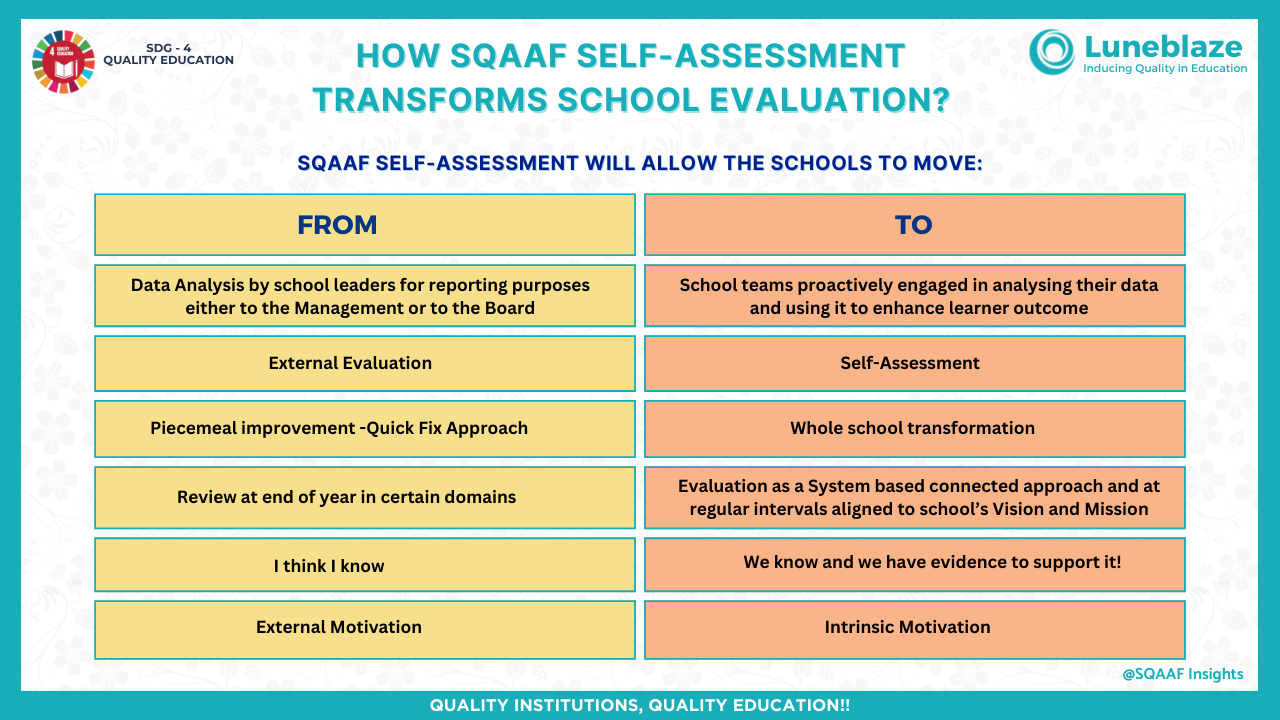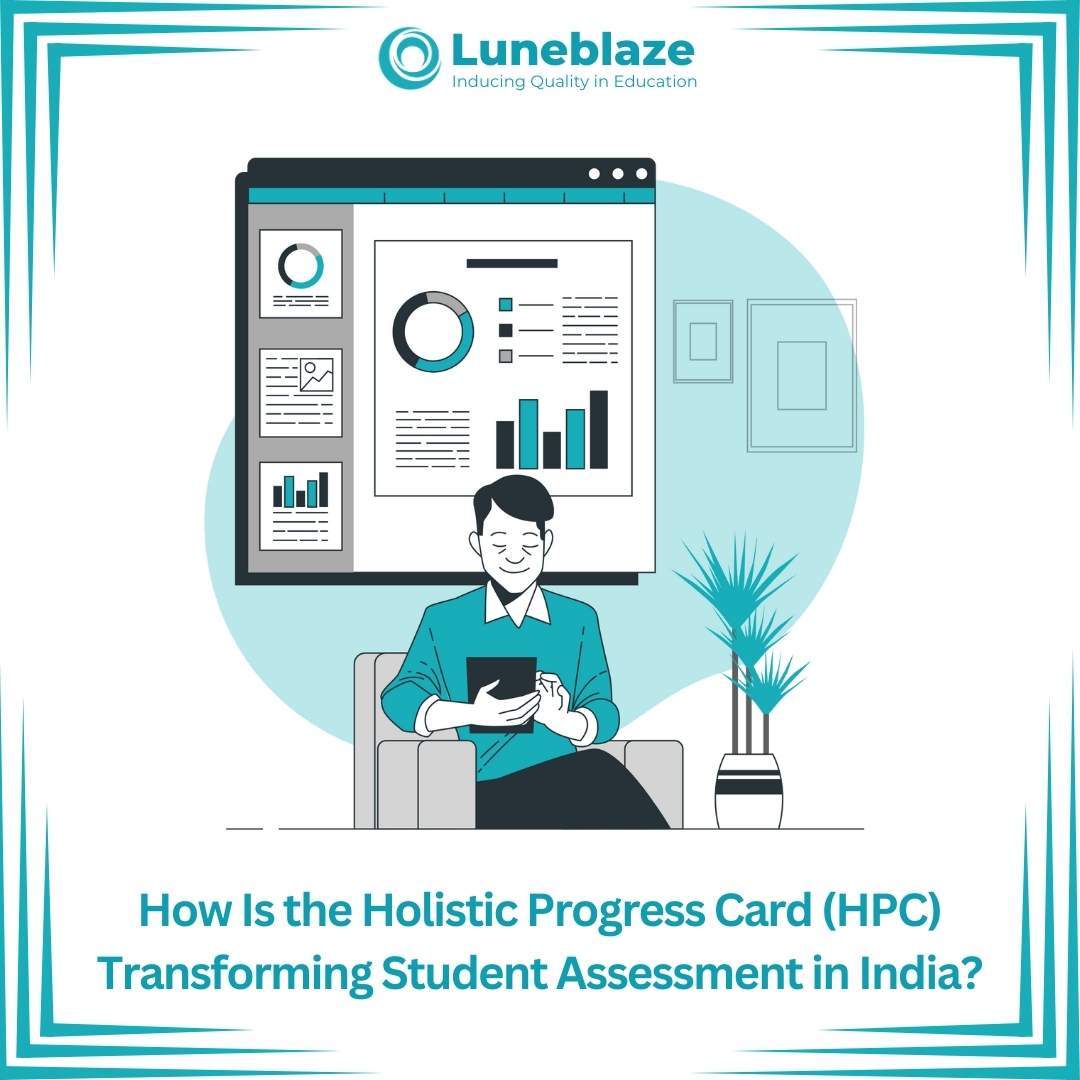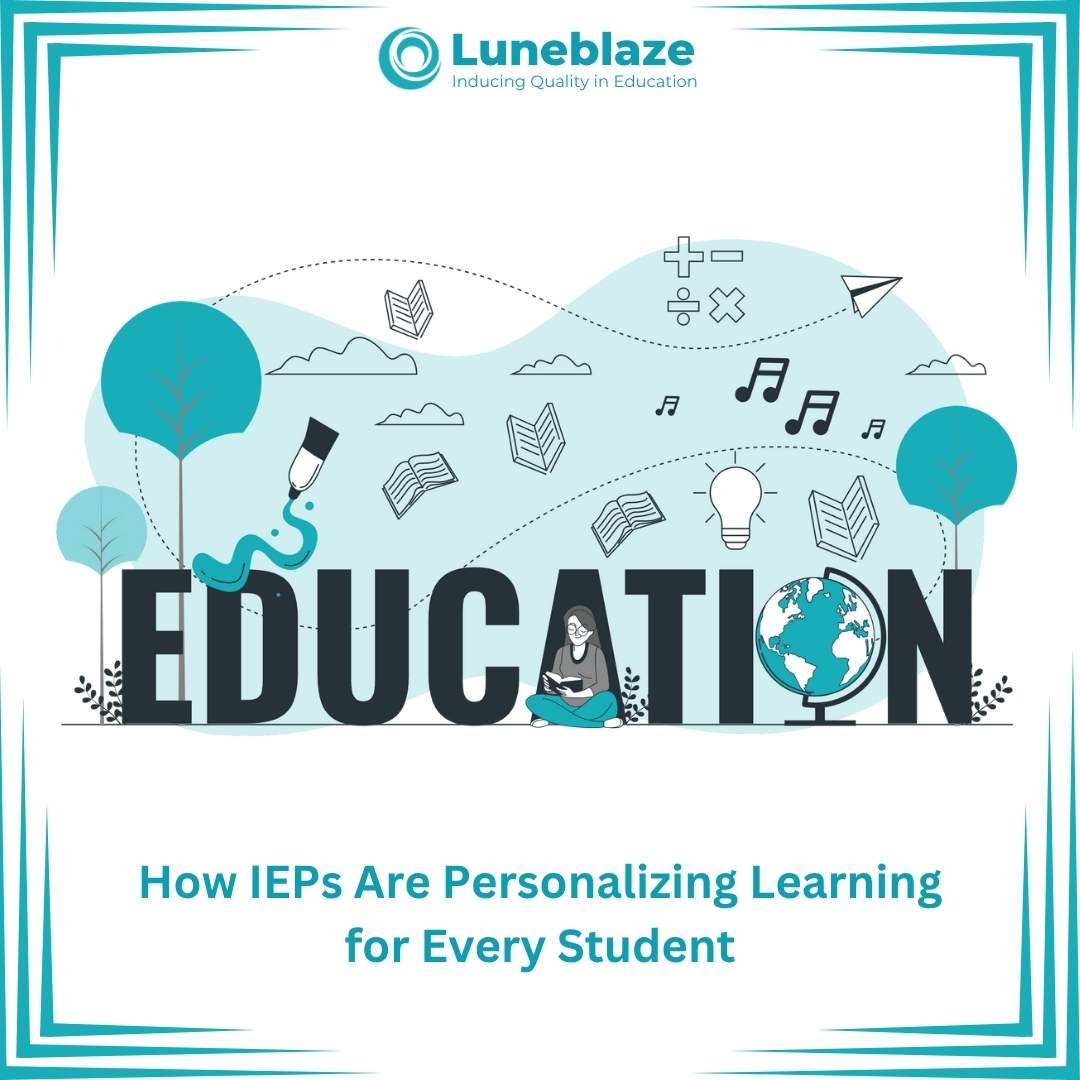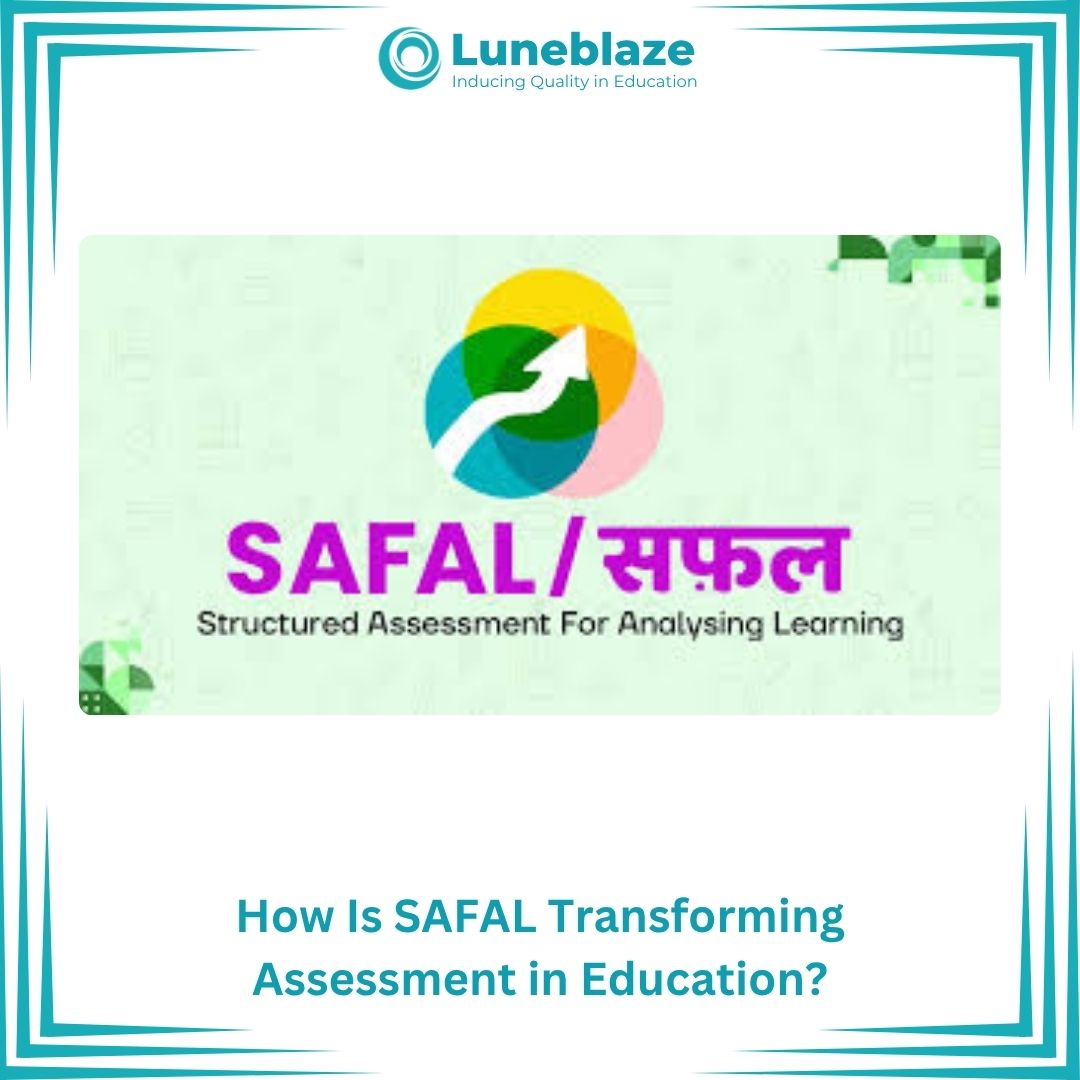How SQAAF Self-Assessment Transforms School Evaluation?

Mar 19, 2025
Imagine a school where every decision made, every action taken, and every strategy implemented is backed by data that is not just collected but understood and used effectively. Picture school leaders, teachers, and staff not merely reviewing reports at the end of a term or year, but actively engaging with the data on an ongoing basis, making informed choices that impact student learning in real-time. This shift in approach isn't just about tracking numbers or measuring school success — it’s about evolving from a reactive, data-driven model to a proactive, evidence-informed one, where the ultimate goal is to enhance learner outcomes.
The CBSE SQAAF (School Quality Assessment and Accreditation Framework) Self-Assessment process is designed to catalyze just such a transformation. It offers a comprehensive and thoughtful method for schools to elevate their evaluation processes, creating a culture of continuous improvement. The process invites schools to not only assess their current state but also work towards building a sustainable and impactful learning environment.
1. Data Analysis for Reporting to Proactive Data Engagement
Historically, many schools relied on data analysis primarily for reporting purposes — whether to the school’s management or to the board. In this model, data was often seen as something necessary to fulfill reporting requirements but didn’t necessarily drive deeper insights/actions within the school. The shift with the SQAAF self-assessment process is a critical one: it encourages school teams to proactively engage in analyzing their own data. Rather than simply summarizing information, school leaders and educators work collaboratively to use data as a tool to inform decisions, with a clear focus on enhancing student outcomes.
2. Moving from External Evaluation to Self-Assessment
Rather than waiting for an external review or evaluation, schools can now evaluate themselves continuously, asking important questions such as: "What are the strengths and weaknesses of our teaching methods? What can our data tell us about our students' progress? How can we use these insights to create a more supportive and effective learning environment?" With this approach, the process moves from external evaluation to self-evaluation, fostering a deeper sense of ownership and responsibility within the school community.
3. From Piecemeal Improvements to Whole School Transformation The move away from external evaluation represents another key shift. Traditionally, many schools used to rely on external bodies or evaluations to assess their performance, sometimes leading to a passive approach to improvement. While external feedback can certainly be valuable, the SQAAF self-assessment process puts the power in the hands of the schools and their educators themselves. Schools are no longer dependent on others to define their progress but are instead encouraged to engage in a continuous, reflective process that aligns with their own vision and mission. This autonomy allows for a more customized and meaningful approach to improvement, where school teams can act based on their unique needs and contexts rather than conforming to a one-size-fits-all model. In the past, school improvement efforts were often piecemeal. There might have been quick fixes — addressing one issue at a time or making incremental changes in isolation. This approach, though sometimes effective in the short term, often lacked the cohesion needed for long-term, sustainable transformation. With the SQAAF self-assessment process, however, schools are encouraged to view improvement through a more holistic lens. The goal is not just to address isolated challenges but to create a comprehensive strategy for school-wide transformation. This could involve reevaluating teaching methodologies, refining learning objectives, improving leadership practices, and aligning every part of the school to a unified vision for growth and success. 4. From Annual Reviews to Ongoing, Systemic Evaluations Part of this transformation involves a shift in the timing and frequency of evaluations. In many traditional systems, reviews occurred at the end of the school year or after a set period, often leading to missed opportunities for timely interventions. With SQAAF, evaluation becomes a continuous and connected process, aligned to the school’s mission and vision. Regular assessments at various intervals provide a more nuanced and ongoing understanding of where the school stands and where it needs to go. This system-based, connected approach ensures that improvements are not just episodic but are deeply embedded in the day-to-day functioning of the school, offering ongoing opportunities for reflection and adjustment. 5. From “I Think I Know” to “We Know and We Have Evidence” The SQAAF self-assessment process also highlights the importance of evidence-based practices. Earlier, there may have been an attitude of "I think I know" when it came to understanding the strengths and weaknesses of the school. There could have been a reliance on gut feeling or subjective opinions rather than solid, reliable data. The transition to "We know and we have evidence to support!" is a powerful one. Schools are encouraged to gather and analyze evidence to substantiate their claims and decisions, ensuring that improvements are grounded in concrete information rather than assumptions. This shift builds confidence in the decision-making process, as every move is backed by data and analysis. 6. From External Motivation to Intrinsic Motivation Lastly, one of the most profound changes the SQAAF self-assessment process fosters is the shift from external motivation to intrinsic motivation. External motivation — driven by external pressures such as inspections, ratings, or outside evaluation — can sometimes lead to superficial or short-term changes. It may prompt schools to make changes merely to meet requirements or appease outside evaluators. However, intrinsic motivation, which comes from within the school community, is far more powerful and sustainable. By actively engaging in the self-assessment process, school leaders and teachers develop a sense of ownership over the improvement journey. They are not merely fulfilling external obligations but are personally invested in making their school the best it can be for their students. 7. The Transformative Power of SQAAF Self-Assessment This intrinsic motivation can be transformative. Teachers and school leaders who are deeply involved in the self-assessment process are more likely to implement changes with passion and commitment. They recognize that the ultimate goal is not just to meet benchmarks but to create a better educational experience for students. The culture of continuous self-improvement becomes embedded in the school’s ethos, leading to more dynamic, innovative, and effective teaching and learning practices. The transition facilitated by the CBSE SQAAF Self-Assessment process represents a profound shift in how schools approach data, evaluation, and improvement. Moving from data analysis for reporting purposes to a proactive engagement with data; shifting from external evaluations to self-assessments; transforming piecemeal improvements into holistic, system-wide changes; and fostering intrinsic motivation over external pressures — all of these elements contribute to a school culture that is not just focused on meeting standards but on exceeding them. With this approach, schools can become places where continuous learning and improvement are not only valued but actively pursued, ensuring better outcomes for all students. To support these efforts, Luneblaze provides a comprehensive AI-enabled end-to-end solution to schools for all their accreditation criteria needs, be it documents & evidence creation, self-assessment filing support on the CBSE SQAAF portal, faculty trainings, audits, and consultancy support. With the help of Luneblaze’s AI-enabled solutions, institutions can organize and manage all their data related to accreditation and assessments like SQAAF for schools.
Trusted by
100+
Institutions
worldwide
since 2017
Get started with Accreditation Excellence
Explore how our AI-enabled accreditation solution simplifies the accreditation journey









